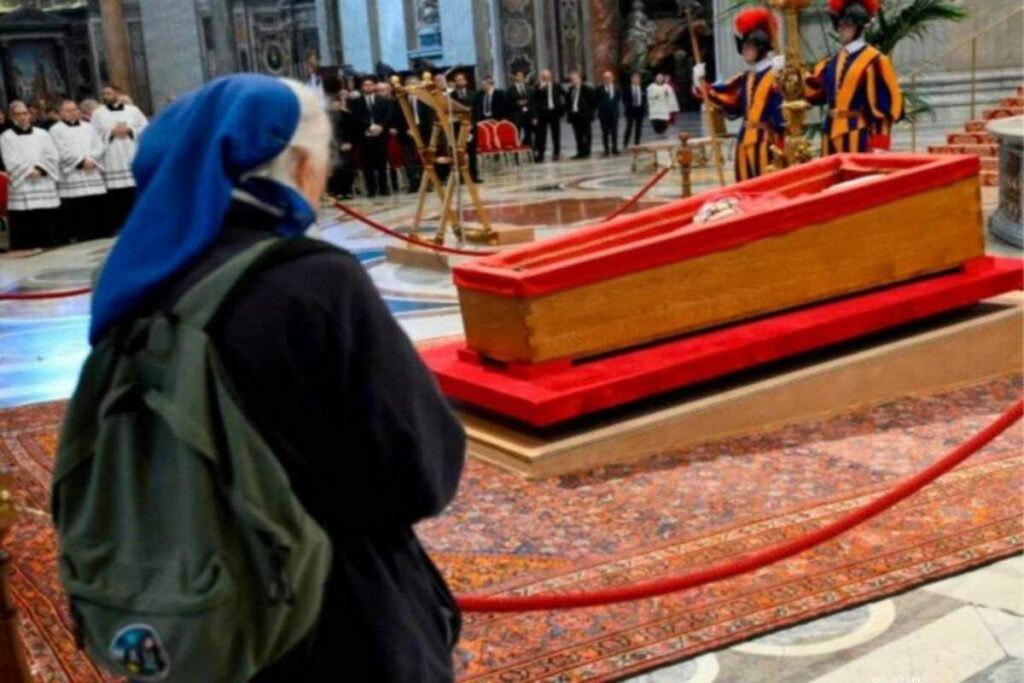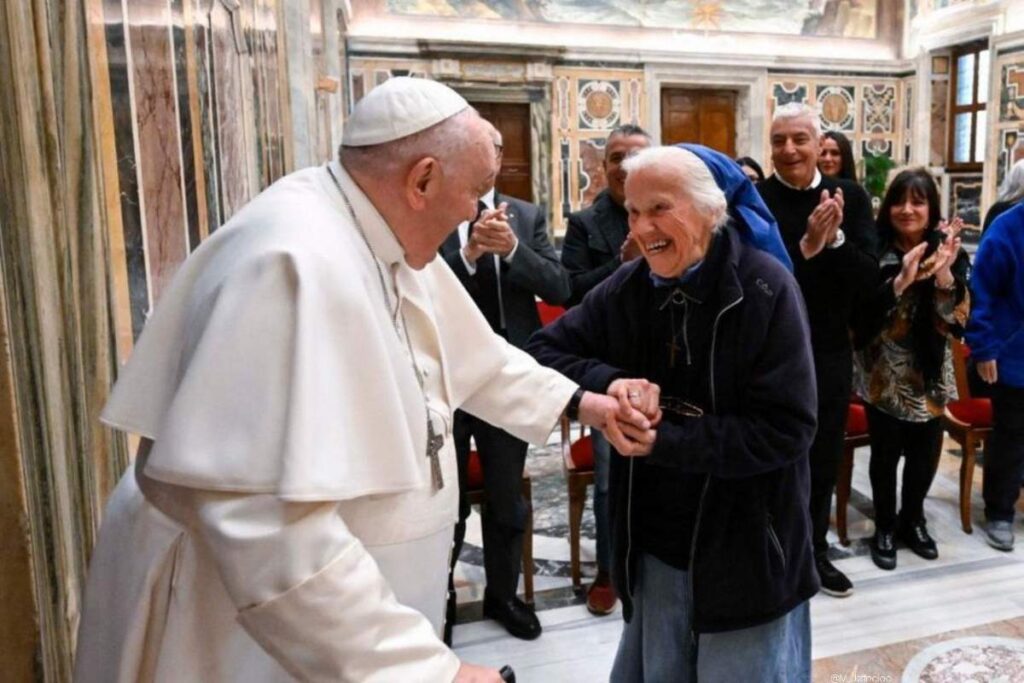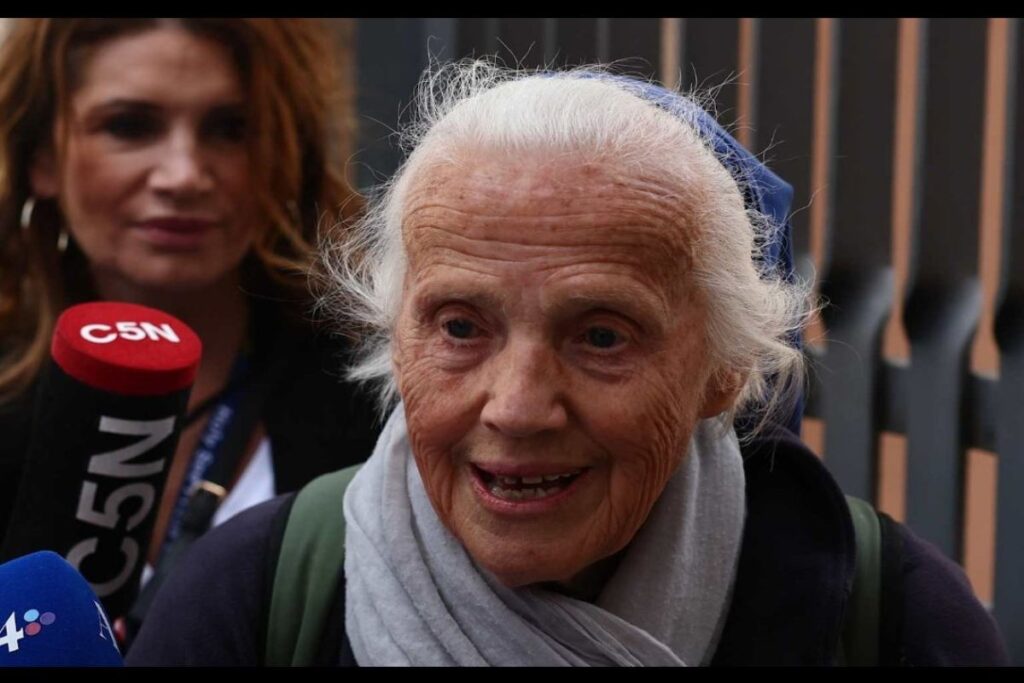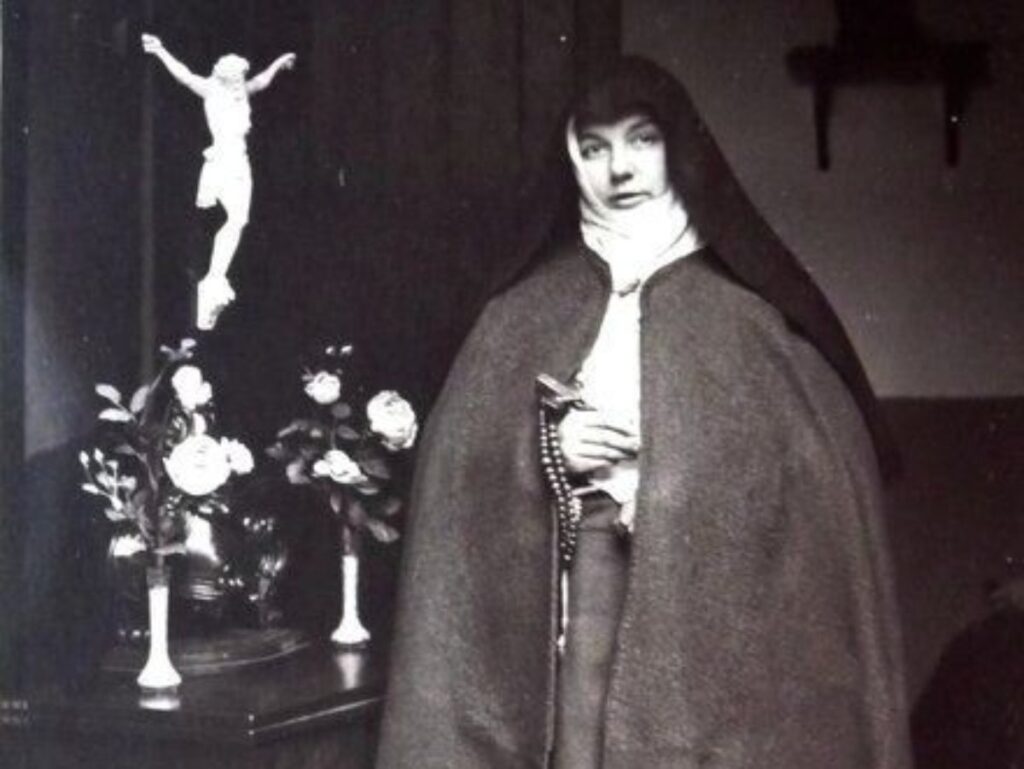While hundreds of millions mourned Pope Francis’s death worldwide, something fascinating happened at the Vatican. Photos began to spread of a small-framed elderly nun standing in grief and prayer a few feet from the Pope’s body. Sister Genevieve has become widely known worldwide.
According to Vatican protocol, the 81-year-old nun wasn’t supposed to be near the pope’s corpse. She is a woman. Vatican rules barred women from approaching the pope’s open wooden casket during his lying-in-state at St.Peter’s Basilica on April 23, 2025. That privilege was reserved for only male clergy.
It was a centuries-old rule that excluded women from the area. But as a group of all-male cardinals paid the late pope their last respects and left the area, Sis Genevieve found a way in. For some reason, Vatican security refused to stop her. They recognized her as one of the most cherished people in the late pope’s life.
As the photos of the grief-stricken Genevieve standing close to the late pope went viral, people began to wonder about her identity and relationship to the former pontiff. Who is Sister Genevieve, and why was she the only woman who could have been allowed to break the long-revered Vatican protocol?

Her story also takes us back to medieval times, from where we can trace instances of women challenging the norms in the church. Let’s explore some exceptional moves made by women in the Catholic Church.
Who Is Sister Genevieve?
Sister Genevieve wasn’t just another mourner paying respects to the late pope. As she said her prayers and wept close to his embalmed body, she must have had flashbacks of their decades-old friendship.
Sister Genevieve Jeanningros is a long-time friend of the late Pope. The French-Argentinian nun serves her Lord from the Little Sisters of Jesus in Italy. She has dedicated her life to serving the downtrodden and marginalized sections of society through the organization. This is how she got to know Pope Francis, who wasn’t yet a pope at the time of their meeting.
Sister Genevieve has mainly catered to fairground workers and trans women. She has changed the world from her humble residence in Luna Park fairground, Ostia, Italy. Through her connections with the late pontiff, some of these despised groups have had the great honor of meeting with the late former pope.

Nicknamed “L’enfant terrible” in reference to her courageous character, Sister Genevieve has challenged the norm and gone to great lengths to defend the downtrodden, which is the objective of her organization.
Since its establishment in 1939, the Little Sisters of Jesus have elevated “the last, the least, and the lost.” Founded by Madeleine Hunt, the organization exemplifies a life of humility and compassion.
Sisters in the organization live among the downtrodden, whether in slums or temporary camps. They share the same life with their host communities, working simple jobs to make a living. Their mission currently serves scores of communities in over 60 countries.
A Special Friendship Begins
Sister Genevieve and Jorge Mario Bergoglio (Pope Francis) met in 2005. At the time, Pope Francis was the Archbishop of Buenos Aires, the Argentinian capital. Sister Genevieve was in the nation’s capital to attend the burial of her aunt Leonie Duquet, who was kidnapped and murdered.
Duquet was kidnapped and murdered in the 1970s during the hostile military reign of the time. The murderous military regime was notorious for killing thousands of people viewed as threats. These included activists and humanitarian workers.

Duquet and 11 other people, including a French nun, were thrown into the sea on December 14, 1977. Duquet’s body was later recovered and buried in a mass grave. However, it was retrieved in 2005 and identified. Pope Francis approved for her body to be given a proper burial.
Genevieve, already displeased with the church’s behaviour during the military rule, expressed her views in a letter. Historical accounts have implicated a section of the church in aiding the military junta of the time.
Her ill-disposition toward the church’s leadership was worsened by the absence of church leaders at her aunt’s re-burial. Her letter captured her sadness and disappointment. Bishop Bergoglio, who was at the Vatican for a meeting, saw her letter and invited her over.
After the meeting, Genevieve was still not convinced by his explanations. She viewed him as part of the irresponsible class of clergymen who ran the church. However, her views changed in 2013 after Bishop Bergoglio emerged as the new pope.
As he was unveiled on the balcony of St. Peter’s Basilica, she recounted feeling worried and uncertain about the church’s future under his leadership. But his actions in office cleared her doubts and won her over.
Partners in Service
Sister Genevieve and Pope Francis soon formed a potent alliance to help the less privileged. She helped him reach more of these people by facilitating meetings, especially during the pope’s weekly audiences. “I always wrote him a little message to tell him who was coming,” she recalled.

Pope Francis also visited her to support her work in her Ostia community. During his June 2024 visit, he blessed a statue and interacted with the elated fairground workers. Genevieve also helped the pope meet some members of the LGBTQ community in the area.
At Pope Francis’ invitation, Genevieve attended mass at the Vatican. The first was at his Santa Marta residence, where she again witnessed his all-inclusive disposition and passion for reaching the unreached and strengthening the downtrodden.
Women Who Defied the Norms in the Catholic Church
Women have repeatedly stepped up to confront hostile aspects of culture. Numerous examples are littered throughout the Bible. Sister Genevieve is just one among many.
Their courage and defiance have also continued to this day. Let’s see some of the most notable examples.
Courageous Women in the Medieval Bible Times
The Bible records the stories of women who were ahead of their time. Figures such as Mary Magdalene, one of Jesus’ most notable disciples, are an example. In a society where women played their roles in the background, Phoebe became an influential personality in the early church.
In the 12th and 14th centuries, women like Hildegard of Bingen and Catherine of Siena wouldn’t be held back. They became super-influential and gave new and valuable direction to theology. These women also became papal advisors, a role deemed too prestigious and intelligent for women to play.
Pioneers of Outstanding Religious Movements
In the 13th century, women took their influence to the next level. They started religious movements across Europe. Clare of Assisi founded the Poor Clares in the Catholic Church in 1212 despite the disapproval of church norms.
She revolutionized the Catholic Church with her decision to live in poverty. This was against church rules that mandated funds be allocated to keep women’s groups financially safe.
She pushed against the rule and forced Pope Gregory IX to deviate from Church custom. In 1228, the pope approved her “Privilege of Poverty” policy. Clare also broke from church rules and ran her group with unprecedented autonomy. This was against tradition, which set women perpetually under male supervision.

In the 16th century, women such as Teresa of Avila rose to become reputed theologians. She challenged male dominance in the church and made significant changes to the Carmelite Order, both in the male and female branches.
Modern Catalysts of Change
In recent times, women have revolutionized the Catholic church. They have raised their voices against exclusion and won many victories. Women have filled roles that were reserved for males.
The modern Catholic Church now has girls serving at the altar—a victory they won in 1994. Women are now lay ministers and, if their advocacy succeeds, may also become deacons.
In 2020, women were finally allowed to become lectors and acolytes. These are the fruits of a series of advocacy movements led by women. But one of the biggest battles is still raging: the push for women’s ordination.
This move has been ongoing for about a century. Mary Daly, a theologian and feminist, has, together with several other influential groups, called for a change in the Catholic system, which many view as largely patriarchal.
In a show of resistance, a “rogue” bishop, Romulo Antonio Braschi, ordained seven women as Roman Catholic Priests in a ship on the Danube River in June 2002. The women who are now known as the Danube Seven were later excommunicated from the church.
More and more women continue to make sacrifices to influence the role of women in the Catholic Church. As unintended as it looks, Sister Genevieve’s action is yet another manifestation of the silent agitation for female recognition. She likely saw Pope Francis as a beacon of the much-needed change in the largest Christian denomination.
Rest in Peace to a Dear Friend
Pope Francis’ friendship and partnership with Sister Genevieve were well known across the Vatican grounds at the time of his death. Little wonder the Vatican guards didn’t deprive her of one last moment with her dear ally. Their friendship was stronger than any centuries-old protocol.
After images of her solemn moment went viral, Sister Genevieve gave an interview in which she described the late pope as “a brother, a pope, [and] a friend.” She added that she paid him her respects daily, whether the cameras were there or not.
As the world remembers the legacy of the Catholic Church’s 266th pope, it will never forget his dear friend, Sister Genevieve, who broke church norms to pay him her last respects. Sister Genevieve is a testament to lasting friendship, the kind the world and every pope earnestly needs.

